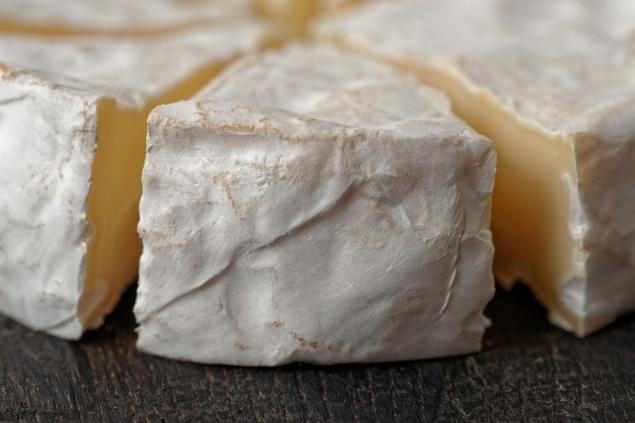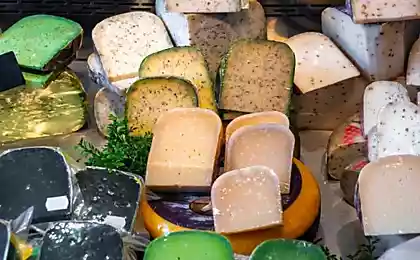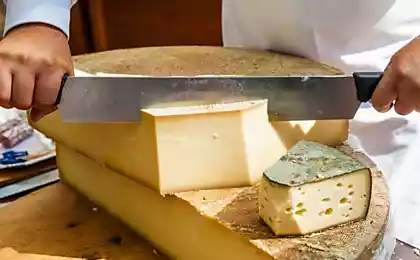221
What is good brie cheese with crust
Brie is a soft cheese made from cow’s milk, derived from the name of the French province near Paris, where it was first produced.

Bree belongs to the most famous and oldest French cheeses, it is rightly called the cheese of kings and the king of cheeses.

Charlemagne, who discovered brie cheese in 774, said, “I have just tasted one of the most exquisite dishes.”
Soft cheeses of the brie family are produced from raw cow's milk. In shape, they are cakes with a diameter of 30-60 cm and a thickness of 3-5 centimeters. A good brie is covered with mold, resembling white velvet in color.

Under the crust is a delicate fluid mass of creamy color, from which comes a slight aroma of hazelnuts. Young brie has a soft and delicate taste, as the flesh matures, it becomes sharp. The thinner the brie cake, the sharper the cheese.
Can I eat a crust? Brie cheese crust It consists entirely of Penicillum candidum, fungi that are found nowhere in nature except cheese. So it is safe to eat even for those who are allergic to mold.

Steve Taylor, director of the Food Allergy Research and Resources Program (FARRP), said: There is no evidence that mold cheeses can be allergenic due to the Penicillum Candidum crust.
Allergy is caused by mold spores entering the respiratory tract, because of this, an allergic reaction to mold is confused with the body's reaction to flowering. Cheese mold is mycelium, not spores, so eating brie crust is absolutely safe.
Moreover, for gourmets, there is a crust of brie - it is part of the cheese gastronomic culture. It should be clarified that bitter and becomes very unpleasant crust of old brie, so try to choose fresh cheese.

Brie cheese boasts a high content of phosphorus, various vitamins and calcium, and mold helps its fuller absorption. However, there are negative aspects: due to the high percentage of fat, brie should be consumed in limited quantities, especially those who follow the figure.
If there is white-mold rarely and gradually, there is no danger to health, but its excessive use can negatively affect the intestinal microflora, especially after gastrointestinal diseases. Fully healthy people are advised to consume no more than 50 grams of brie cheese per day.
How to serve brie cheese Brie cheese is usually served in slices together with a crust. If you don’t like the crust and are afraid to try it (in vain!), just separate it from the cheese with a knife. It is better to cut it from edge to center, so as not to squeeze out the soft inner part.

You can eat brie on your own, but it is even better to include it in the cheese plate, supplemented with grapes, pears, white crackers, candied walnuts, honey or jam. Brie can be warmed up in the oven (in foil) before serving on the table, so it will be easier to smear it on toast and crackers.

Brie cheese is great for baking champignons under cheese. And heated in an oven with cranberry sauce, he is beyond praise!
If you are not familiar with brie cheese, we advise you to quickly correct this annoying omission, and the king of cheeses will fully “open” to you all his taste.

Bree belongs to the most famous and oldest French cheeses, it is rightly called the cheese of kings and the king of cheeses.

Charlemagne, who discovered brie cheese in 774, said, “I have just tasted one of the most exquisite dishes.”
Soft cheeses of the brie family are produced from raw cow's milk. In shape, they are cakes with a diameter of 30-60 cm and a thickness of 3-5 centimeters. A good brie is covered with mold, resembling white velvet in color.

Under the crust is a delicate fluid mass of creamy color, from which comes a slight aroma of hazelnuts. Young brie has a soft and delicate taste, as the flesh matures, it becomes sharp. The thinner the brie cake, the sharper the cheese.
Can I eat a crust? Brie cheese crust It consists entirely of Penicillum candidum, fungi that are found nowhere in nature except cheese. So it is safe to eat even for those who are allergic to mold.

Steve Taylor, director of the Food Allergy Research and Resources Program (FARRP), said: There is no evidence that mold cheeses can be allergenic due to the Penicillum Candidum crust.
Allergy is caused by mold spores entering the respiratory tract, because of this, an allergic reaction to mold is confused with the body's reaction to flowering. Cheese mold is mycelium, not spores, so eating brie crust is absolutely safe.
Moreover, for gourmets, there is a crust of brie - it is part of the cheese gastronomic culture. It should be clarified that bitter and becomes very unpleasant crust of old brie, so try to choose fresh cheese.

Brie cheese boasts a high content of phosphorus, various vitamins and calcium, and mold helps its fuller absorption. However, there are negative aspects: due to the high percentage of fat, brie should be consumed in limited quantities, especially those who follow the figure.
If there is white-mold rarely and gradually, there is no danger to health, but its excessive use can negatively affect the intestinal microflora, especially after gastrointestinal diseases. Fully healthy people are advised to consume no more than 50 grams of brie cheese per day.
How to serve brie cheese Brie cheese is usually served in slices together with a crust. If you don’t like the crust and are afraid to try it (in vain!), just separate it from the cheese with a knife. It is better to cut it from edge to center, so as not to squeeze out the soft inner part.

You can eat brie on your own, but it is even better to include it in the cheese plate, supplemented with grapes, pears, white crackers, candied walnuts, honey or jam. Brie can be warmed up in the oven (in foil) before serving on the table, so it will be easier to smear it on toast and crackers.

Brie cheese is great for baking champignons under cheese. And heated in an oven with cranberry sauce, he is beyond praise!
If you are not familiar with brie cheese, we advise you to quickly correct this annoying omission, and the king of cheeses will fully “open” to you all his taste.























